Abstract
In this study, Cu and Cu2O hybrid nanoparticles were synthesized onto the WO3 nanoflake film using a one-step electrodeposition method. The critical advance is the use of a heterojunction consisting of WO3 flakes and Cu2O as an innovative stack design, thereby achieving excellent performance for CO2 photoreduction with water vapor under visible light irradiation. Notably, with the modified Cu nanoparticles, the selectivity of CH4 increased from nearly 0% to 96.7%, while that of CO fell down from 94.5% to 0%. The yields of CH4, H2 and O2 reached 2.43, 0.32 and 3.45 mmol/gcat after 24 h of visible light irradiation, respectively. The boosted photocatalytic performance primarily originated from effective charge-transfer in the heterojunction and acceleration of electron-proton transfer in the presence of Cu nanoparticles. The S-scheme charge transfer mode was further proposed by the in situ-XPS measurement. In this regard, the heterojunction construction showed great significance in the design of efficient catalysts for CO2 photoreduction application.
1. Introduction
The rapid growth of atmospheric carbon dioxide (CO2) concentration has attracted considerable attention due to its greenhouse effect on the global climate [1,2]. Developing artificial photosynthesis routes by reducing anthropogenic CO2 emissions using solar energy instead of carbon-based fuels such as methane, methanol or carbon monoxide is still an intensive research topic in the environmental and energy field [2,3,4]. Since a TiO2 photocatalyst was used to reduce CO2 into methanol and formaldehyde by Inoue et al. in 1972 [5], most semiconductor photocatalysts, such as g-C3N4, CeO2, W18O49 and Bi2WO6 have received immense attention for CO2 reduction under visible light irradiation, which occupies 44% of solar light [6,7,8,9,10,11]. Among the common photocatalysts, WO3 material has gradually gained special scientific interest due to its relatively narrow bandgap (Eg~2.8 eV) and unique crystal structure containing a network of corner-shared octahedral units of [WO6], which could theoretically utilize 12% of solar light and enhance charge migration in the catalyst [12]. Although WO3 crystals exhibit various phases, few studies have focused on hexagonal phase WO3 (h-WO3) for photocatalytic CO2 reduction [8,13,14]. h-WO3 not only exhibits excellent visible light responsive properties according to its good photochromic ability [15], but also strong CO2 adsorption at low-pressure due to the presence of ultramicro-sized tunnels [16]. It is thus considered as a potential visible-light-driven (VLD) photocatalyst for CO2 reduction. However, the application of photocatalytic CO2 reduction for h-WO3 is seriously hindered by poor charge separation and reduction ability [17,18].
It is well known that two-dimensional (2D) semiconductors exhibit superior solar-driven photocatalytic activity as a result of improved photoexcited charge separation, compared with that of bulk photocatalysts [19,20]. The 2D nanostructure also greatly influences the optical properties and electronic properties of semiconductors [21]. In particular, the travel distance of photoexcited carriers in the WO3 nanoflake becomes short, and more photons can be adsorbed by the nanoflake in a remarkably short time under low photon flux density due to its large surface area [22]. It is thus considered that h-WO3 nanoflakes could reduce charge recombination and improve the performance of photocatalytic CO2 reduction. In addition, there have been few reports on the hydrothermal fabrication of nanostructured h-WO3 photocatalysts [16,23,24], and the metastable hexagonal phase has limited its development and application [17,25]. Therefore, it is still a conceptual challenge in the field of materials research to fabricate heat-resisting h-WO3 nanoflakes for CO2 reduction. Apart from nanostructure engineering, heterojunction construction is also a prospective way of achieving improved redox abilities and efficient separation of photoexcited electrons and holes for h-WO3 [2,26]. Among the numerous heterojunction photocatalysts, the heterostructured system with a staggered band alignment has drawn much attention due to its efficient charge separation [27]. Notably, the charge transfer (step-scheme mode) in the above junction directly quenches the weaker oxidative holes and reductive electrons, which is preferable to obtain photoexcited carriers with stronger redox abilities [28]. Recently, cuprous oxide (Cu2O) with a conduction band of −1.15 eV (vs. NHE) has been utilized as a VLD semiconductor photocatalyst or co-catalyst for CO2 reduction [29,30]. Nevertheless, Cu2O exhibits weak oxidation ability and poor photostability. An effective way to address these issues may be coupling Cu2O and WO3 to construct a heterostructured system with a step-scheme (S-scheme) charge transportation mode. S-scheme systems consisting of monoclinic or orthorhombic WO3 and Cu2O were constructed for organic degradation, CO2 reduction or photoelectrocatalytic water splitting [31,32,33]. To our best knowledge, there are few studies regarding hexagonal phase WO3 nanoflakes and Cu2O for photocatalytic CO2 reduction under visible light irradiation.
Except for enhanced photocatalytic activity for CO2 reduction, the selectivity of multiple hydrocarbon products plays a key role in their further application in the chemical industry. The influence of the specific surface structure of the photocatalyst cannot be ignored in the process of CO2 reduction [34,35]. Due to the eight-electron reaction of CH4 generation from CO2, loading co-catalysts with fast electron transfer, including Au, Pt, Ag and Ti, could be conductive to control the reduction of products [35,36,37,38]. Non-noble-metal Cu co-catalyst has become a newly emerging research spot for CO2 reduction. Albo et al. reported the deposition of Cu nanoparticles on the TiO2 surface, which facilitated the photocatalytic process from CO2 to CH3OH [39]. Meng et al. proved that Cu co-catalyst played a pivotal role in increasing methane selectivity in the CO2 photoreduction process for the S doped g-C3N4 catalyst [40]. In the Cu2O/WO3 system, loading Cu co-catalysts can originate from Cu2O with unsaturated coordination sites dispersed on the surface of the catalyst, and offer more catalytic centers and act as the electron sink to increase the concentration of charge carriers. Therefore, the construction of a Cu/Cu2O/WO3 catalyst could accelerate charge separation across the Cu2O/WO3 heterojunction interface and modulate product selectivity for photocatalytic CO2 reduction.
Herein, we report the synthesis of Cu and Cu2O species onto WO3 nanoflakes by a one-step electrodeposition method. The photocatalytic performances for CO2 reduction with water vapor over the obtained samples were investigated under visible light irradiation (λ > 400 nm), and the influence of Cu nanoparticles on product selectivity was studied. The band structure of the heterojunction was measured and the S-scheme charge-transfer mode was further verified.
2. Materials and Methods
2.1. Materials Synthesis
WO3 nanoflake film was synthesized by the solvothermal-calcination method. Before solvothermal growth, a thin seed layer was deposited onto the fluorine-doped tin oxide (FTO)-coated glass substrate (2.3 cm × 2.0 cm) by spin coating the precursor solution, which was made by dissolving 1.25 g of H2WO4 in 30 wt% H2O2 (8 mL), followed by annealing at 500 °C for 2 h in air. The H2WO4 solution for solvothermal treatment was prepared by dissolving 1.25 g of H2WO4 into 30 wt% H2O2 (15 mL) and heating at 95 °C for 2 h. Nanoflake growth was achieved using 3 mL of H2WO4 solution mixed with 0.5 mL of HCl (6 mol/L) and 12.5 mL of acetonitrile. A vertically oriented FTO-glass substrate was immersed into the above solution and placed within a Teflon lined stainless steel autoclave, which was then sealed and maintained at 180 °C for 3 h. The substrate was then rinsed with deionized water and dried in air. The WO3 nanoflake film was obtained after annealing at 500 °C for 2 h in air.
The electrodeposition was performed in a standard three-electrode system. The FTO substrates (2.3 cm × 2.0 cm) were used as the working electrodes. The platinum sheet (1.0 cm × 1.0 cm × 0.2 cm) and Ag/AgCl electrode were used as the counter and reference electrodes, respectively. All of the chemicals were used without further purification. Before electrodeposition, the substrates were rinsed with distilled water and then cleaned by ultrasonic treatment in ethanol for 10 min. Cu2O was electrodeposited in 0.02 mol/L Cu(OAc)2 aqueous solution (50 mL) containing 0.02 mol/L acetic acid (5 mL) using chronopotentiometry at −0.4 V with 0.5 s for 150 cycles. The Cu/Cu2O sample was obtained at −0.7 V under the similar conditions as above.
Cu2O/WO3 and Cu/Cu2O/WO3 films were synthesized by electrodeposition of Cu2O and Cu/Cu2O on the obtained WO3 nanoflakes, respectively. Typically, the deposition process was conducted in Cu(OAc)2 aqueous solution (0.02 mol/L, 50 mL) using chronopotentiometry electrodeposition with 0.5 s in 150 cycles, and the Cu2O/WO3 and Cu/Cu2O/WO3 films samples were obtained at −0.4 and −0.7 V, respectively. All the samples were then rinsed with deionized water and dried in air. Additionally, Cu2O and Cu/Cu2O films were prepared by the similar method, and Cu2O and Cu/Cu2O nanoparticles were broken off from the above samples by the ultrasound method. The dispersion solutions of Cu2O and Cu/Cu2O nanoparticles were then severally sprayed onto the WO3 nanoflakes, and the obtained films were finally denoted as Cu2O/WO3 m and Cu/Cu2O/WO3 m samples.
2.2. Characterization
The crystal phases of the samples were recorded using an X−ray diffractometer (PANalytical X’ pert PRO, Netherlands) with a Cu Kα irradiation source (λ = 0.154 nm) and 0.15°/s scanning step. A scanning electron microscope (SEM, Nova NanoSEM 450, FEI) using the acceleration 300 kV voltage was used to characterize the morphology of the obtained products. Transmission electron microscopy (TEM) was obtained on a Tecnai G2 F20 S-TWIN electron microscope. Furthermore, high-resolution transmission electron microscopy (HRTEM) and Energy Dispersive X-ray spectroscopy (EDX) was employed and the corresponding fast Fourier transform (FFT) was evaluated by Gatan Digital Micro-graph software (Gatan Inc., Pleasanton, CA, USA). X-ray photoelectron spectroscopy (XPS) measurements were carried out at room temperature on a Thermo escalab 250Xi X-ray Photoelectron Spectrometer with a monochromatic Al Kα radiation (hv = 1486.6 eV). For XPS analysis, the samples without exposure to air were dried in N2 flow gas and vacuum packed to avoid any impurity. All spectra were calibrated to the C1s peak at 284.6 eV. The peak position was estimated using a fitting procedure based on the summation of Lorentzian and Gaussian functions using the XPSPEAK 4.1 program. UV-Vis diffuse reflectance spectra (DRS) were performed on a scan UV-Vis spectrometer (Cary 5000). The composition for the composites was determined by ICP-AES analysis using Thermo Scientic iCAP 6000 spectrometry. The photoelectrochemical test was recorded in a conventional three-electrode system by a CHI 660E electrochemical workstation (Chenhua, Shanghai, China). The photocurrents of the photocatalysts were measured at 0.0 V (vs. Ag/AgCl) in Na2SO4 aqueous solution after being purged by N2 under UV-visible light with an AM 1.5 G filter.
2.3. Photocatalytic Performance Tests
Photocatalytic CO2 reduction activity with gaseous phase H2O was evaluated in a CEL-HPR100 stainless steel cylindrical vessel (Beijing China Education Au-Light Co., Ltd., China), and the light source was a PLS-SXE 300 Xenon arc lamp with a UV cutoff filter (λ > 400 nm). The compressed high purity CO2 gas (99.995%) was passed across a deionized water bubbler, which generated a mixture of CO2 and H2O vapor. After visible-light irradiation, the product yields and types in the gas phase were analyzed using a GC-7890II gas chromatograph (Beijing China Education Au-Light Co., Ltd., China), and the hydrocarbon product was further analyzed by 7890A-5975C GC-MS (Agilent Technologies Inc., Santa Clara, CA, USA). The experimental process is detailed in Supplementary Material S1.
The product selectivity (S) for CO2 reduction was calculated with the following Equations (1)–(3):
SCO (%) = 2 × NCO/(2 × NCO + 8 × NCH4 + 2 × NH2) × 100
SH2 (%) = 2 × NH2/(2 × NCO + 8 × NCH4 + 2 × NH2) × 100
SCH4 (%) = 2 × NCH4/(2 × NCO + 8 × NCH4 + 2 × NH2) × 100
NCO, NCH4 and NH2 were on behalf of the yield of detected CO, CH4 and H2 molecules in the photocatalytic process of CO2 reduction with H2O vapor.
3. Results and Discussion
3.1. Structure, Composition and Morphology
The XRD patterns of the as-prepared samples are presented in Figure 1. Several diffraction peaks at 13.9, 23.2, 27.2, 28.1, 47.4 and 49.8°(marked with black dotted lines) were observed corresponding to (1 0 0), (0 0 2), (1 0 2), (2 0 0), (0 0 4) and (2 2 0) planes of hexagonal WO3 (PDF card No. 01-085-2460). This is because the percentage of exposed facets was estimated by the respective peak areas of the facets [41]. Hence, the WO3 component in the bare and composite samples preferentially exposed (0 0 2) facets. Simultaneously, the diffraction peaks of Cu2O sample (marked with green dotted lines) matched perfectly with those of cubic phase Cu2O (PDF card No. 01-078-2076). To further explore the existence of Cu metal in the composite, the XRD pattern of Cu/Cu2O sample was studied, avoiding interference from the diffraction peak of hexagonal WO3, and the characteristic peaks at 43.4 and 50.6° (marked with pink dotted lines) were attributed to metallic Cu (PDF card No. 03-065-9743). Moreover, Cu metal was proven to be present in the Cu/Cu2O/WO3 composite. As a result, Cu and Cu2O were simultaneously electrodeposited onto hexagonal WO3, indicating the successful construction of the Cu/Cu2O/WO3 composite.
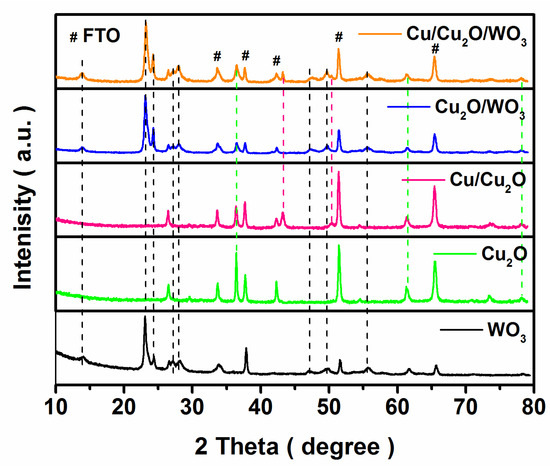
Figure 1.
XRD patterns of the bare and composite samples (# sign: the characteristic peak of FTO substrate).
X-ray photoelectron spectroscopy (XPS) measurements were carried out to elucidate the surface composition and chemical states of the elements. The survey XPS spectrum of the typical Cu/Cu2O/WO3 sample indicated that the composite mainly consisted of W, Cu and O electrons. To gain further insight into the chemical bonding between W and other atoms in the composite, the high resolution XPS spectrum of W 4f (Figure 2a) was deconvoluted by Gaussian-Lorenzian analysis. The peaks at binding energies of 37.7 and 35.7 eV were ascribed to W (VI) state in tungsten oxide materials, while two distinct peaks at 34.5 and 36.4 eV were consistent with the values of W (V) oxidation state for all the samples [42,43]. The existence of W (V) was necessary to maintain the opening structure of hexagonal WO3 [14]. However, the area ratios of W (V) and W (VI) in the composite were higher than those of the bare WO3 sample (Table S1) due to the electroreduction process for Cu2O deposition. In the high-resolution Cu 2p XPS spectrum (Figure 2b), two conspicuous peaks were observed at binding energies of 952.3 eV for Cu (I) 2p1/2 and 932.5 eV for Cu(I) 2p3/2 [44]. Furthermore, the Cu and W diffraction peaks of the composite shifted slightly compared with those of pure samples, which was the reason that the intense interaction existed between WO3 and Cu2O component in the composites, implying the formation of heterojunction. Cu LMM Auger spectra (Figure 2c) were further performed to explore the chemical state of the Cu element, The Auger parameter can be calculated from the equation of α′ = Ek (Auger electron) + Eb (photoelectron). Here, Ek is the kinetic energy, and Eb is the binding energy. The Auger parameter values of the Cu (I) and Cu (0) in the Cu/Cu2O/WO3 composite were determined to be 1848.7 and 1851.2 eV, respectively, which indicated the existence of Cu (I) and Cu (0) in the Cu/Cu2O/WO3 sample [45,46].
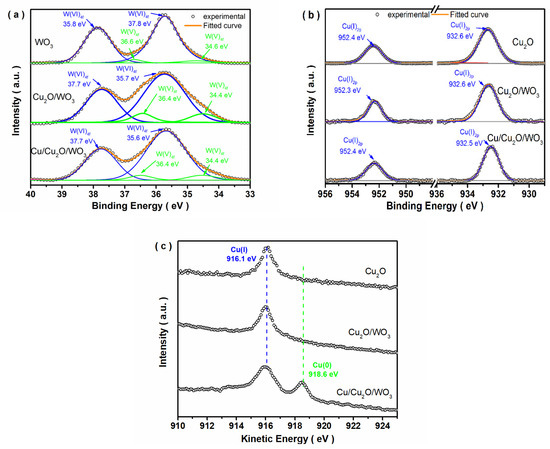
Figure 2.
XPS spectra (a): W 4f, (b): Cu 2p, and Cu LMM auger spectra (c) of the obtained samples.
The morphologies of the as-obtained WO3, Cu2O/WO3 and Cu/Cu2O/WO3 powders were visualized using SEM images. As shown in Figure 3, all the samples exhibited the typical sheet morphology with various sizes. Furthermore, the SEM image in Figure 3a showed that the nanoflake surface was rough and porous. As shown in Figure 3b,c, both of the composites kept uniform sheet morphology, and the sheet thicknesses after electro-deposition of Cu2O and Cu/Cu2O had no obvious changes compared with that of bare WO3. Although there was no obvious difference in Cu content between Cu2O/WO3 and Cu/Cu2O/WO3 according to the ICP-AES analysis (Table S2), the nanoflake surface of Cu/Cu2O/WO3 exhibited distinct embossment (Figure 3c).

Figure 3.
SEM images of WO3 (a), Cu2O/WO3 (b) and Cu/Cu2O/WO3 (c) samples.
Micro-structures of the obtained samples were investigated by TEM observation. Figure 4 revealed that the typical nanoflake-like morphology was observed with a sharp edge and clean boundary. In Figure 4a, the WO3 nanoflake had a porous surface morphology. The fringe spacings of 0.634 and 0.366 nm were discovered (inset of Figure 4a), which were consistent with the (1 0 0) and (0 0 2) lattice planes of hexagonal WO3, respectively. In Figure 4b, Cu2O/WO3 still kept a nanoflake-like morphology with smaller porous sizes compared with that of WO3. The lattice fringes with spacings of 0.246 and 0.213 nm were distinctly found (inset of Figure 4b) corresponding to the (1 1 1) and (2 0 0) planes of cubic Cu2O. Similar nanoflake-like morphology was observed for the Cu/Cu2O/WO3 sample in Figure 4c, and the (2 0 0) crystal facet of metallic Cu with lattice spacing of 0.180 nm was observed, except for the crystal facet of Cu2O (top-right inset of Figure 4c). Furthermore, the scattered Cu nanoparticles around the Cu/Cu2O/WO3 nanoflake by ultrasonic exfoliation were observed with clear lattice fringes of 0.180 and 0.208 nm were observed around the nanoflake (bottom-left inset of Figure 4c), and the size distribution of Cu nanoparticles in the selected area (framed in red, corresponding enlarged view in Figure S1) obeyed a logical normal distribution with an average diameter of 5.6 ± 1.1 nm (Figure S2). According to the elemental mapping images in Figure 4d, W, Cu and O elements were uniformly distributed in the Cu/Cu2O/WO3 sample, and the Cu element appeared on the surface, as well as around the nanoflakes. The above results demonstrate that Cu2O was uniformly electrodeposited on the surface of the WO3 nanoflake, and metallic Cu also existed in the Cu/Cu2O/WO3 sample.
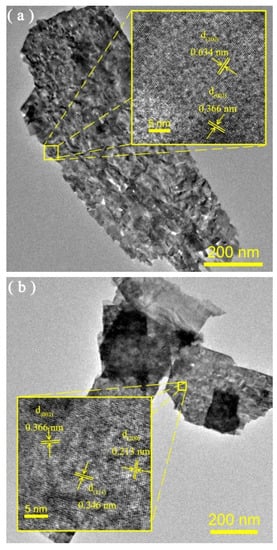
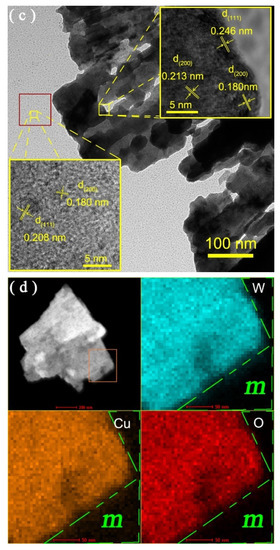
Figure 4.
TEM images of WO3 (a), Cu2O/WO3 (b) and Cu/Cu2O/WO3 (c), inset: HRTEM images), and elemental mapping images of Cu/Cu2O/WO3 (d).
The light absorption property is crucial for the utilization efficiency of solar energy for the catalyst. According to the UV-Vis diffuse reflectance spectra (Figure 5), all the composites showed strong absorption in the visible light region, indicating the feasibility of utilizing visible light for CO2 photoreduction. The band gaps (Eg) of the samples were estimated by the plots of (αhν)2 versus photo energy (hν) (Figure S3 and Table S2), and the calculated Eg values of WO3 and Cu2O were 2.86 and 2.05 eV, respectively.
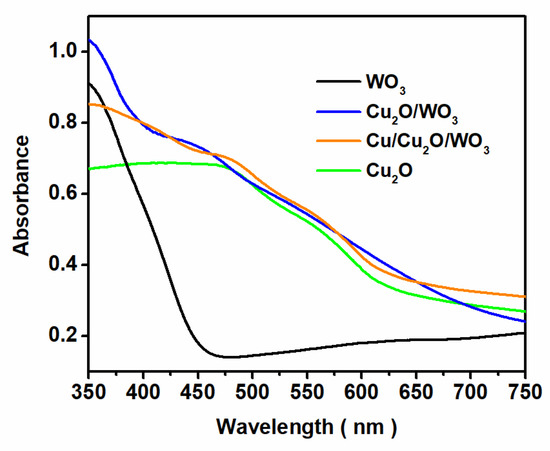
Figure 5.
UV-Vis diffuse reflectance spectra of WO3, Cu2O, Cu2O/WO3 and Cu/Cu2O/WO3 composites.
3.2. Photocatalytic Performance of CO2 Reduction
The photocatalytic CO2 reduction experiments were carried out under visible-light irradiation (> 400 nm) for the as-prepared catalysts. The photocatalytic performances of CO2 reduction with water vapor in Figure 6a showed that no products were generated over the WO3, Cu2O and Cu/Cu2O samples. Conversely, CO, CH4, O2 and H2 products were obtained for the Cu/Cu2O/WO3 and Cu2O/WO3 composites, and no other products such as HCHO or CH3OH were detected by either GC or GC-MS analyses. Furthermore, the product yields decreased for the mechanically dispersed Cu2O/WO3 m sample compared with those of the Cu2O/WO3, indicating that the loosely contacted interface was insufficient for photocatalytic CO2 reduction. Additionally, the product selectivity for CO2 reduction was analyzed for the Cu/Cu2O/WO3 and Cu2O/WO3 catalyst. Typically, the SCH4 and SCO values of Cu2O/WO3 were calculated to be about 0.1% and 94.5%, which demonstrated that CO2 reactant was thermodynamically favorable to form CO by the two-electron reduction pathway. However, the ScH4 and SCO values of Cu/Cu2O/WO3 were calculated to be 96.7% and 0.0%, indicating that the metallic Cu promoted the formation and utilization of proton-assisted multi-electrons pathway in the photocatalytic CO2 reduction process [47]. The CH4, CO and O2 yields for CO2 photoreduction reached 1.87, 0.0065 and 2.63 mmol/gcat, respectively. Compared with the photocatalytic activity of the reported catalysts (Table S3), the maximum rate of CH4 product over Cu/Cu2O/WO3 was obviously higher and high product selectivity was also obtained. To explore the influence of loading Cu on the photocatalytic performance, the controlled experiments in different atmospheres were further investigated (Figure 6b). In the CO/H2O atmosphere, more CH4 molecules were produced over Cu/Cu2O/WO3 compared with that of Cu2O/WO3. Meanwhile, in the N2/H2O atmosphere, the H2 yield from water splitting was improved with the existence of Cu in the composite, which indicated that Cu nanoparticles promoted the electron transfer and proton aggregation on the catalyst surface, improving the hydrogenated process for CO2 reduction over the Cu/Cu2O/WO3 catalyst. The yields of products for the Cu/Cu2O/WO3 composite were further investigated in the CO2/H2O atmosphere within 24 h of irradiation. As shown in Figure 6c, the total yields of CH4, H2 and O2 were enhanced with prolonging the irradiation time. The maximal yield rate of H2 reached 0.013 mmol/gcat/h at 24 h, and those of CH4 and O2 at 18 h were found to be 0.104 and 0.147 mmol/gcat/h, respectively. The decreased yields of the photocatalytic CO2 reduction were possibly due to oxidation of the formed carbonous compounds on the photocatalyst surface or the coverage of active sites by intermediates. Reproducibility and durability are critical for the long-term use of a catalyst in practical application. The results in Figure 6d show that the yields of CH4 and H2 for the typical Cu/Cu2O/WO3 catalyst slightly decreased, and the O2 yield obviously fell down after 5 cycles. Notably, after the 5th cycling experiment, the photocatalyst was regenerated by the electro-reduction method at 0.05 V in 0.5 M Na2SO4 solution. In the 6th cycling experiment, all the yields were obviously promoted, which were similar to those of the fresh catalyst. To illustrate the stability of the Cu/Cu2O/WO3 catalyst, XPS measurements were conducted to investigate the change in chemical composition after the 5th cycle. As shown in the Cu 2p and W 4f XPS spectra (Figure S4), Cu (II) and W (V) were identified, which were probably derived from the oxidation of Cu (I) and reduction in W (VI), and W (V) possibly became the high recombination center of the photogenerated electrons and holes, leading to a slight decrease in the photocatalytic activity for CO2 reduction.

Figure 6.
Photocatalytic performances of CO2 reduction with water vapor after 18 h of visible light irradiation (>400 nm) over different samples (a), photocatalytic activities under different atmospheres (b), the yields of products for the Cu/Cu2O/WO3 composite in the CO2/H2O atmosphere within 24 h of irradiation (c) and product yields for the Cu/Cu2O/WO3 catalyst in cycling experiment under visible light irradiation for 18 h (d).
3.3. Possible Photocatalytic Mechanism
Transient photocurrent response and photoluminescence spectra were measured to investigate the charge separation. Based on the photo-electric properties during several on–off illumination cycles (Figure 7a), the photocurrent density of Cu2O/WO3 was higher than those of the bare WO3 and Cu2O samples, and the Cu/Cu2O/WO3 sample exhibited the highest photo-induced density among them. Moreover, the photoluminescence spectra of the photocatalysts at the excitation wavelength of 405 nm are present in Figure 7b, and the emission intensity of the Cu/Cu2O/WO3 composite distinctly decreased compared with those of the WO3, Cu2O and Cu2O/WO3 samples. The above results indicate the promoted separation of photogenerated electron-hole pairs in the Cu/Cu2O/WO3 composite.
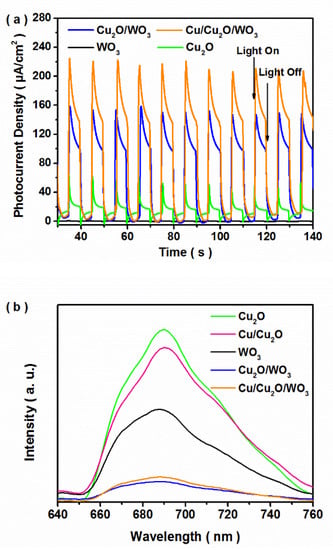
Figure 7.
Photocurrent density (a) and photoluminescence spectra (b) of the obtained samples.
The band edge position and charge transport mode in the composite directly influenced the separation and redox ability of photoexcited charge carriers. Ultraviolet photoelectron spectra combined with Eg analysis were used to determine the electronic band structure of the catalyst. Figure 8a shows the UPS spectra of Cu2O and WO3. On the basis of the linear intersection method [48], the valence band (VB) of WO3 was estimated to be −7.33 eV (vs. vacuum), and the conduction band (CB) was −4.47 eV (vs. vacuum) based on the Eg value of WO3. According to the connection between vacuum energy and normal electrode potential (NHE) [29], the corresponding VB and CB positions of WO3 were 2.89 and 0.03 eV (vs. NHE), respectively. Similarly, the VB and CB values of Cu2O were separately calculated to be 0.91 and −1.14 eV (vs. NHE), which agreed well with previously reported results [31,49]. Hence, the heterostructure with staggered band alignment was successfully formed in this Cu2O/WO3 system, assuming that the possible band bending of the semiconductor was neglected. Based on the band energy structure of WO3 and Cu2O, two possible mechanisms for photo-induced carriers were proposed and described in Figure 8b,c. If the photo-excited charge carriers transferred according to the traditional model (Figure 8b), the photo-excited holes in the VB of WO3 would transfer to the VB of Cu2O, and the photo-excited electrons in the CB of Cu2O would migrate to the CB of WO3, where the accumulated electrons would not reduce CO2 to CO/CH4 or produce H2 from H2O on account of the more positive CB edge potential (0.21 eV vs. NHE) than the standard CO2 reduction potential [4]. Similarly, the accumulated holes in Cu2O would not accomplish H2O oxidation due to the more negative VB of Cu2O. Hence, the hypothesis of the traditional double-transfer model was invalid. The S-scheme charge transfer mode (Figure 8c) was proposed according to the enhanced photocatalytic activity of Cu/Cu2O/WO3. To verify the S-scheme charge transfer mode in this heterojunction, the XPS spectra of Cu2O/WO3 were measured in light and the results were shown in Figure 8d,e. The CB of Cu2O and WO3 were composed of Cu and W orbitals, respectively. Four peaks of W 4f in light shifted to a higher binding energy compared with these in the dark. Simultaneously, two peaks of Cu 2p in light reversely shifted. It was implied that the photo-induced electrons transferred from WO3 component to Cu2O component in this heterojunction [50,51]. Specifically, the photoexcited holes in the VB of Cu2O would transfer to WO3 and recombine with the photoexcited electrons in the CB of WO3. The CB potential of Cu2O and VB potential of WO3 thermodynamically realized photocatalytic CO2 reduction and H2O oxidation, respectively, and the metallic Cu co-catalyst facilitated the reduction process dynamically.
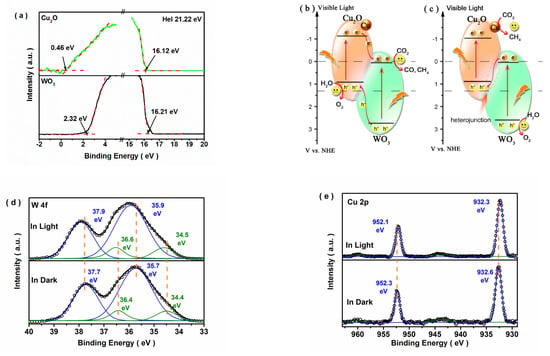
Figure 8.
Ultraviolet photoelectron spectra of Cu2O and WO3 samples measured at the basics of −8 V (a), photocatalytic electron transfer modes of the Cu/Cu2O/WO3 composite: the traditional double transfer mode (b) and the S-scheme charge transfer mode (c), and XPS spectra of W 4f (d) and Cu 2p (e) for Cu2O/WO3 heterojunction in dark/light.
4. Conclusions
In summary, Cu and Cu/Cu2O species were synthesized on the hexagonal WO3 nanoflake films by the one-step electrodeposition method for photocatalytic CO2 reduction with water vapor. The obtained Cu/Cu2O/WO3 catalyst exhibited excellent photocatalytic performance under visible light irradiation (λ > 400 nm) due to the construction of heterojunction, and the CH4, H2 and O2 yields reached 2.43, 0.32 and 3.45 mmol/gcat after 24 h of illumination, respectively. Notably, CH4 molecules were generated as the major product over the Cu/Cu2O/WO3 catalyst, whereas Cu2O/WO3 facilitated CO generation. Efficient CH4 formation for the Cu/Cu2O/WO3 catalyst was attributed to the modification of Cu nanoparticles favoring electron–proton transfer from CO to CH4. The decreased photocatalytic activity in the cycling experiment was recovered by the regenerated treatment via electro reduction, removing the superfluous W(V) in the composite. Additionally, the S-scheme charge transfer mode and potential mechanism of CO2 reduction were proposed by the results of XPS measurement and photocatalytic performance under light illumination with a specific wavelength. The present research may provide a promising strategy to design ternary nanocomposite VLD photocatalysts and inspire further interest in tuning product selectivity for photocatalytic CO2 conversion.
Supplementary Materials
The following supporting information can be downloaded at: https://www.mdpi.com/article/10.3390/nano12132284/s1, S1. Catalytic Experiment for CO2 photoreduction; Table S1. ICP-AES analysis of Cu2O/WO3 and Cu/Cu2O/WO3 samples; Table S2. Band gaps of pure WO3, Cu2O, Cu2O/WO3 and Cu/Cu2O/WO3 samples; Table S3. Comparison of performance CO2 conversion of the obtained material with other reported catalysts. Figure S1. TEM image of Cu nanoparticles in Cu/Cu2O/WO3 sample; Figure S2. Size distribution histogram of Cu nanoparticles.; Figure S3. The curves of (αhν)2 versus photo energy (hν); Figure S4. XPS spectra of Cu/Cu2O/WO3 in the cycling tests.
Author Contributions
Conceptualization, W.S., A.C. and J.-C.W.; software, X.X. and S.W.; validation, J.-C.W. and Y.H.; formal analysis, R.L. W.Z. and J.-C.W.; investigation, W.S.; resources, J.-C.W., R.L., W.Z. and Y.H.; data curation, J.-C.W.; writing—original draft preparation, X.X. and J.-C.W.; writing—review and editing, S.W.; supervision, W.S. and J.-C.W.; project administration, W.S. and J.-C.W.; funding acquisition, J.-C.W., R.L., W.Z. and Y.H. All authors have read and agreed to the published version of the manuscript.
Funding
This research was funded by the financial supports of National Natural Science Foundation of China (No. 51802082 and 51903073), Natural Science Foundation of Henan Province (No. 212300410221), Program for Science & Technology Innovation Talents in Universities of Henan Province (No. 21HATIT016), Key Scientific Research Project of Colleges and Universities in Henan Province (No. 21A430030), Key Scientific and Technological Project of Henan Province (No. 222102320100), National College Student Innovantion and Entrepreneurship Training (No. 202110467024) and “Climbing” Project of Henan Institute of Science and Technology (No. 2018CG04).
Data Availability Statement
Data are contained within the article.
Conflicts of Interest
The authors declare no conflict of interest.
References
- Wang, K.; Wang, T.; Islam, Q.A.; Wu, Y. Layered double hydroxide photocatalysts for solar fuel production. Chin. J. Catal. 2021, 42, 1944–1975. [Google Scholar] [CrossRef]
- Wang, H.N.; Zou, Y.H.; Sun, H.X.; Chen, Y.; Li, S.L.; Lan, Y.Q. Recent progress and perspectives in heterogeneous photocatalytic CO2 reduction through a solid-gas mode. Coord. Chem. Rev. 2021, 438, 213906. [Google Scholar] [CrossRef]
- Wang, B.; Liu, J.W.; Yao, S.; Liu, F.Y.; Li, Y.K.; He, J.Q.; Lin, Z.; Huang, F.; Liu, C.; Wang, M.Y. Vacancy engineering in nanostructured semiconductors for enhancing photocatalysis. J. Mater. Chem. A 2021, 9, 17143–17172. [Google Scholar] [CrossRef]
- Navarro-Jaen, S.; Virginie, M.; Bonin, J.; Robert, M.; Wojcieszak, R.; Khodakov, A.Y. Highlights and challenges in the selective reduction of carbon dioxide to methanol. Nat. Rev. Chem. 2021, 5, 564–579. [Google Scholar] [CrossRef]
- Inoue, T.; Fujishima, A.; Konishi, S.; Honda, K. Photoelectrocatalytic reduction of carbon dioxide in aqueous suspensions of semiconductor powers. Nature 1979, 277, 637–638. [Google Scholar] [CrossRef]
- Lu, Q.Q.; Eid, K.; Li, W.P.; Li, W.; Abdullah, A.M.; Xu, G.B.; Varma, R.S. Engineering graphitic carbon nitride (g-C3N4) for catalytic reduction of CO2 to fuels and chemicals: Strategy and mechanism. Green Chem. 2021, 23, 5394–5428. [Google Scholar] [CrossRef]
- Hezam, A.; Namratha, K.; Drmosh, Q.A.; Ponnamma, D.; Wang, J.; Prasad, S.; Ahamed, M.; Cheng, C.; Byrappa, K. CeO2 nanostructures enriched with oxygen vacancies for photocatalytic CO2 reduction. ACS Appl. Energy Mater. 2020, 3, 138–148. [Google Scholar] [CrossRef] [Green Version]
- Zhang, M.; Cheng, G.; Wei, Y.; Wen, Z.; Chen, R.; Xiong, J.; Li, W.; Han, C.; Li, Z. Cuprous ion (Cu+) doping induced surface/interface engineering for enhancing the CO2 photoreduction capability of W18O49 nanowires. J. Colloid Interface Sci. 2020, 572, 306–317. [Google Scholar] [CrossRef]
- Liu, Y.; Shen, D.; Zhang, Q.; Lin, Y.; Peng, F. Enhanced photocatalytic CO2 reduction in H2O vapor by atomically thin Bi2WO6 nanosheets with hydrophobic and nonpolar surface. Appl. Catal. B 2021, 283, 119630. [Google Scholar] [CrossRef]
- Chen, D.; Zhang, X.; Lee, A.F. Synthetic strategies to nanostructured photocatalysts for CO2 reduction to solar fuels and chemicals. J. Mater. Chem. A 2015, 3, 14487–14516. [Google Scholar] [CrossRef] [Green Version]
- Zhao, G.; Huang, X.; Wang, X.; Wang, X. Progress in catalyst exploration for heterogeneous CO2 reduction and utilization: A critical review. J. Mater. Chem. A 2017, 5, 21625–21649. [Google Scholar] [CrossRef]
- Wang, H.; Zhang, L.; Wang, K.; Sun, X.; Wang, W. Enhanced photocatalytic CO2 reduction to methane over WO3·0.33H2O via Mo doping. Appl. Catal. B 2019, 243, 771–779. [Google Scholar] [CrossRef]
- Xie, Y.P.; Liu, G.; Yin, L.; Cheng, H.M. Crystal facet-dependent photocatalytic oxidation and reduction reactivity of monoclinic WO3 for solar energy conversion. J. Mater. Chem. 2012, 22, 6746–6751. [Google Scholar] [CrossRef]
- Tian, F.H.; Zhao, L.; Xue, X.-Y.; Shen, Y.; Jia, X.; Chen, S.; Wang, Z. DFT study of CO sensing mechanism on hexagonal WO3 (0 0 1) surface: The role of oxygen vacancy. Appl. Surf. Sci. 2014, 311, 362–368. [Google Scholar] [CrossRef]
- Li, N.; Zhao, Y.; Wang, Y.; Lu, Y.; Song, Y.; Huang, Z.; Li, Y.; Zhao, J. Aqueous synthesis and visible-light photochromism of metastableh-WO3 hierarchical nanostructures. Eur. J. Inorg. Chem. 2015, 17, 2804–2812. [Google Scholar] [CrossRef]
- Sun, W.; Yeung, M.T.; Lech, A.T.; Lin, C.-W.; Lee, C.; Li, T.; Duan, X.; Zhou, J.; Kanar, R.B. High surface area tunnels in hexagonal WO3. Nano Lett. 2015, 15, 4834–4838. [Google Scholar] [CrossRef]
- Dong, P.; Hou, G.; Xi, X.; Shao, R.; Dong, F. WO3-based photocatalysts: Morphology control, activity enhancement and multifunctional applications. Environ. Sci. Nano 2017, 4, 539–557. [Google Scholar] [CrossRef]
- Yang, G.; Zhu, X.; Cheng, G.; Chen, R.; Xiong, J.; Li, W.; Li, Y. Engineered tungsten oxide-based photocatalysts for CO2 reduction: Categories and roles. J. Mater. Chem. A 2021, 9, 22781–22809. [Google Scholar] [CrossRef]
- Babu, V.J.; Vempati, S.; Uyar, T.; Ramakrishna, S. Review of one-dimensional and two-dimensional nanostructured materials for hydrogen generation. Phys. Chem. Chem. Phys. 2015, 17, 2960–2986. [Google Scholar] [CrossRef]
- Chen, W.; Hou, X.; Shi, X.; Pan, H. Two-dimensional Janus transition metal oxides and chalcogenides: Multifunctional properties for photocatalysts, electronics. ACS Appl. Mater. Interfaces 2018, 10, 35289–35295. [Google Scholar] [CrossRef]
- Sumesh, C.K.; Peter, S.C. Two-dimensional semiconductor transition metal based chalcogenide based heterostructures for water splitting applications. Dalton Trans. 2019, 48, 12772–12802. [Google Scholar] [CrossRef] [PubMed]
- Hao, S.; Zhao, X.; Cheng, Q.; Xing, Y.; Ma, W.; Wang, X.; Zhao, G.; Xu, X. A mini review of the preparation and photocatalytic properties of two-dimensional materials. Front. Chem. 2020, 8, 582146. [Google Scholar] [CrossRef] [PubMed]
- Wang, X.; Zhang, H.; Liu, L.; Li, W.; Cao, P. Controlled morphologies and growth direction of WO3 nanostructures hydrothermally synthesized with citric acid. Mater. Lett. 2014, 130, 248–251. [Google Scholar] [CrossRef]
- Peng, T.; Ke, D.; Xiao, J.; Wang, L.; Hu, J.; Zan, L. Hexagonal phase WO3 nanorods: Hydrothermal preparation, formation mechanism and its photocatalytic O2 production under visible-light irradiation. J. Solid State Chem. 2012, 194, 250–256. [Google Scholar] [CrossRef]
- Zheng, G.; Wang, J.; Liu, H.; Murugadoss, V.; Zu, G.; Che, H.; Lai, C.; Li, H.; Ding, T.; Gao, Q.; et al. Tungsten oxide nanostructures and nanocomposites for photoelectrochemical water splitting. Nanoscale 2019, 11, 18968–18994. [Google Scholar] [CrossRef]
- Lin, N.; Lin, Y.; Qian, X.; Wang, X.; Su, W. Construction of a 2D/2D WO3/LaTiO2N Direct Z-scheme photocatalyst for enhanced CO2 reduction performance under visible light. ACS Sustain. Chem. Eng. 2021, 9, 13686–13694. [Google Scholar] [CrossRef]
- Moniz, S.J.A.; Shevlin, S.; Martin, D.; Guo, Z.X.; Tang, J.J. Visible-light driven heterojunction photocatalystsfor water splitting-a critical review. Energy Environ. Sci. 2015, 8, 731–759. [Google Scholar] [CrossRef]
- Xu, Q.; Zhang, L.; Cheng, B.; Fan, J.; Yu, J. S-scheme heterojunction photocatalyst. Chem 2020, 6, 1543–1559. [Google Scholar] [CrossRef]
- Wang, J.-C.; Zhang, L.; Fang, W.-X.; Ren, J.; Li, Y.-Y.; Yao, H.-C.; Wang, J.-S.; Li, Z.-J. Enhanced photoreduction CO2 activity over direct Z-scheme alpha-Fe2O3/Cu2O heterostructures under visible light irradiation. ACS Appl. Mater. Interfaces 2015, 16, 8631–8639. [Google Scholar] [CrossRef]
- Zhai, Q.; Xie, S.; Fan, W.; Zhang, Q.; Wang, Y.; Deng, W.; Wang, Y. Photocatalytic conversion of carbon dioxide with water into methane: Platinum and copper(I) oxide co-catalysts with a core-shell structure. Angew. Chem. Int. Ed. 2013, 52, 5776–5779. [Google Scholar] [CrossRef]
- Ali, H.; Guler, A.C.; Masar, M.; Urbanek, P.; Urbanek, M.; Skoda, D.; Suly, P.; Machovsky, M.; Galusek, D.; Kuritka, I. Solid-state synthesis of direct Z-scheme Cu2O/WO3 nanocomposites with enhanced visible-light photocatalytic performance. Catalysts 2021, 11, 293. [Google Scholar] [CrossRef]
- Hao, J.; Qi, B.; Wei, J.; Li, D.; Zeng, F. A Z-scheme Cu2O/WO3 heterojunction for production of renewable hydrocarbon fuel from carbon dioxide. Fuel 2021, 287, 119439. [Google Scholar] [CrossRef]
- Zhang, J.; Ma, H.P.; Liu, Z.F. Highly efficient photocatalyst based on all oxides WO3/Cu2O heterojunction for photoelectrochemical water splitting. Appl. Catal. B 2017, 201, 84–91. [Google Scholar] [CrossRef]
- Guo, J.; Wan, Y.; Zhu, Y.; Zhao, M.; Tang, Z. Advanced photocatalysts based on metal nanoparticle/metalorganic framework composites. Nano Res. 2021, 14, 2037–2052. [Google Scholar] [CrossRef]
- Cho, H.; Kim, W.D.; Yu, J.; Lee, S.; Lee, D.C. Molecule-driven shape control of metal co-catalysts for selective CO2 conversion photocatalysis. ChemCatChem 2018, 10, 5679–5688. [Google Scholar] [CrossRef]
- Qiu, G.; Wang, R.; Han, F.; Tao, X.; Xiao, Y.; Li, B. One-step synthesized Au-Bi2WO6 hybrid nanostructures: Synergistic effects of Au nanoparticles and oxygen vacancies for promoting selective oxidation under visible light. Ind. Eng. Chem. Res. 2019, 58, 17389–17398. [Google Scholar] [CrossRef]
- Li, R.; Luan, Q.; Dong, C.; Dong, W.; Tang, W.; Wang, G.; Lu, Y. Light-facilitated structure reconstruction on self-optimized photocatalyst TiO2@BiOCl for selectively efficient conversion of CO2 to CH4. Appl. Catal. B 2021, 286, 119832. [Google Scholar] [CrossRef]
- Wang, S.; Teramura, K.; Hisatomi, T.; Domen, K.; Asakura, H.; Hosokawa, S.; Tanaka, T. Highly selective photocatalytic conversion of carbon dioxide by water over Al-SrTiO3 photocatalyst modified with silver-metal dual cocatalysts. ACS Sustain. Chem. Eng. 2021, 9, 9327–9335. [Google Scholar] [CrossRef]
- Albo, J.; Qadir, M.I.; Samperi, M.; Fernandes, J.A.; Pedro, I.D.; Dupont, J. Use of an optofluidic microreactor and Cu nanoparticles synthesized in ionic liquid and embedded in TiO2 for an efficient photoreduction of CO2 to methanol. Chem. Eng. J. 2021, 404, 126643. [Google Scholar] [CrossRef]
- Ojha, N.; Bajpai, A.; Kumar, S. Visible light-driven enhanced CO2 reduction by water over Cu modified S-doped g-C3N4. Catal. Sci. Technol. 2019, 9, 4598–4613. [Google Scholar] [CrossRef]
- Zhang, J.; Zhang, P.; Wang, T.; Gong, J. Monoclinic WO3 nanomultilayers with preferentially exposed (002) facets for photoelectrochemical water splitting. Nano Energy 2015, 11, 189–195. [Google Scholar] [CrossRef]
- Liu, J.; Yu, S.; Zhu, W.; Yan, X. Oxygen vacancy-enhanced visible light-driven photocatalytic activity of TiO2 sphere-W18O49 nanowire bundle heterojunction. Appl. Catal. A 2015, 500, 30–39. [Google Scholar] [CrossRef]
- Yue, C.; Zhu, X.; Rigutto, M.; Hensen, E. Acid catalytic properties of reduced tungsten and niobium-tungsten oxides. Appl. Catal. B 2015, 163, 370–381. [Google Scholar] [CrossRef]
- Lee, K.Y.; Hwang, H.; Shin, D.; Choi, W. Enhanced thermopower wave via nanowire bonding and grain boundary fusion in combustion of fuel/CuO-Cu2O-Cu hybrid composites. J. Mater. Chem. A 2015, 3, 5457–5466. [Google Scholar] [CrossRef]
- Mao, Y.; He, J.; Sun, X.; Li, W.; Lu, X.; Gan, J.; Liu, Z.; Gong, L.; Chen, J.; Liu, P.; et al. Electrochemical synthesis of hierarchical Cu2O stars with enhanced photoelectrochemical properties. Electrochim. Acta 2012, 62, 1–7. [Google Scholar] [CrossRef]
- Moretti, G.; Beck, H.P. On the Auger parameter of Cu(II) compounds. Surf. Interface Anal. 2022, 54, 803–812. [Google Scholar] [CrossRef]
- Liu, S.; Xia, J.; Yu, J. Amine-functionalized titanate nanosheet-assembled yolk@shell microspheres for efficient cocatalyst-free visible-light photocatalytic CO2 Reduction. ACS Appl. Mater. Interfaces 2015, 7, 8166–8175. [Google Scholar] [CrossRef]
- Liu, J.; Liu, Y.; Liu, N.; Han, Y.; Zhang, X.; Huang, H.; Lifshitz, Y.; Lee, S.-T.; Zhong, J.; Kang, Z. Metal-free efficient photocatalyst for stable visible water splitting via a two-electron pathway. Science 2015, 347, 970–974. [Google Scholar] [CrossRef]
- Pu, Y.C.; Lin, W.H.; Hsu, Y.-C. Modulation of charge carrier dynamics of NaxH2−xTi3O7-Au-Cu2O Z-scheme nanoheterostructures through size effect. Appl. Catal. B 2015, 163, 343–351. [Google Scholar] [CrossRef]
- Cui, D.; Hao, W.; Chen, J. The synergistic effect of heteroatom doping and vacancy on the reduction of CO2 by photocatalysts. ChemNanoMat 2021, 7, 894–901. [Google Scholar] [CrossRef]
- Oropeza, F.E.; Dzade, N.Y.; Pons-Marti, A.; Yang, Z.; Zhang, K.H.L.; de Leeuw, N.H.; Hensen, E.J.M.; Hofmann, J.P. Electronic structure and interface energetics of CuBi2O4 photoelectrodes. J. Phys. Chem. C 2020, 124, 22416–22425. [Google Scholar] [CrossRef] [PubMed]
Publisher’s Note: MDPI stays neutral with regard to jurisdictional claims in published maps and institutional affiliations. |
© 2022 by the authors. Licensee MDPI, Basel, Switzerland. This article is an open access article distributed under the terms and conditions of the Creative Commons Attribution (CC BY) license (https://creativecommons.org/licenses/by/4.0/).